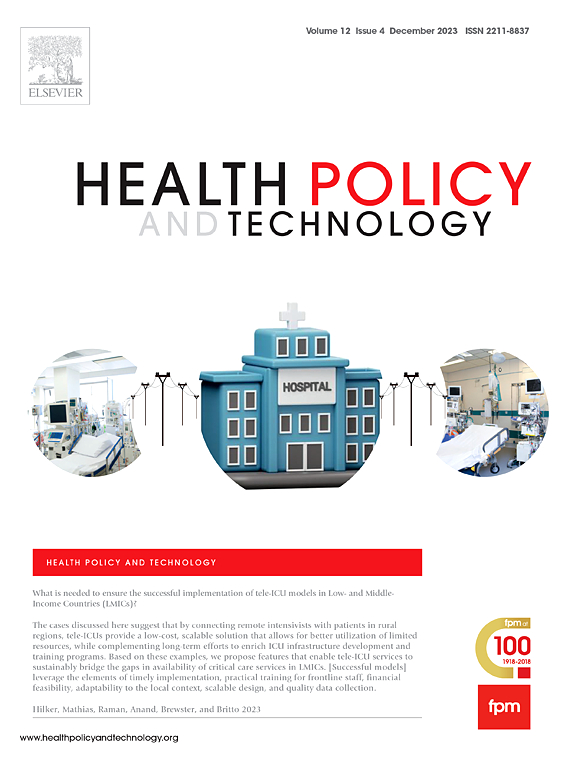Musculoskeletal complaints following hospitalization for COVID-19 infection
IF 3.4
3区 医学
Q1 HEALTH POLICY & SERVICES
引用次数: 0
Abstract
Objectives
The term post- or long-COVID syndrome describes >50 possible long-term effects on various organ systems following COVID-19 infection. The pathophysiology of most symptoms remains unclear, and the time course of symptom onset varies widely.
Methods
Using a telephone survey and validated questionnaires we investigated the incidence of musculoskeletal complaints after inpatient treatment for COVID-19 infection compared with patients hospitalized for a non-COVID diagnosis.
Results
112 patients were followed up for least 6 months after discharge (range 6–21 months). Hospitalized and ICU-treated COVID patients showed significant changes in WOMAC scores for the lower extremities (Kruskal-Wallis test, p = 0.005). There is also a significant change in the post-discharge question about new limb complaints (Chi-squared test, p = 0.005), regardless of whether the patients received intensive care or not. The majority of COVID patients with joint or muscle symptoms describe them as widespread and much less frequently as localized and restricted to one region.
Conclusions
In addition to the already known long-term effects, there is evidence that patients with COVID who have been treated in an inpatient setting may also suffer from long-term musculoskeletal effects. Women of working age are particularly affected by the resulting limitations.
因COVID-19感染住院后的肌肉骨骼疾病
“后或长期covid综合征”一词描述了COVID-19感染后对各器官系统可能产生的50种长期影响。大多数症状的病理生理尚不清楚,症状发作的时间过程差异很大。方法采用电话调查和有效问卷调查的方式,对因COVID-19感染住院治疗后的肌肉骨骼疾病发生率与因非COVID-19诊断住院的患者进行比较。结果112例患者出院后至少随访6个月(6 ~ 21个月)。住院和icu治疗的患者下肢WOMAC评分有显著变化(Kruskal-Wallis检验,p = 0.005)。无论患者是否接受重症监护,出院后关于新肢体主诉的问题也有显著变化(χ 2检验,p = 0.005)。大多数出现关节或肌肉症状的COVID - 19患者将其描述为广泛存在,而很少出现局部和局限于一个区域的情况。结论除了已知的长期影响外,有证据表明,在住院环境中接受治疗的COVID患者还可能遭受长期的肌肉骨骼影响。工作年龄的妇女特别受到由此产生的限制的影响。
本文章由计算机程序翻译,如有差异,请以英文原文为准。
求助全文
约1分钟内获得全文
求助全文
来源期刊

Health Policy and Technology
Medicine-Health Policy
CiteScore
9.20
自引率
3.30%
发文量
78
审稿时长
88 days
期刊介绍:
Health Policy and Technology (HPT), is the official journal of the Fellowship of Postgraduate Medicine (FPM), a cross-disciplinary journal, which focuses on past, present and future health policy and the role of technology in clinical and non-clinical national and international health environments.
HPT provides a further excellent way for the FPM to continue to make important national and international contributions to development of policy and practice within medicine and related disciplines. The aim of HPT is to publish relevant, timely and accessible articles and commentaries to support policy-makers, health professionals, health technology providers, patient groups and academia interested in health policy and technology.
Topics covered by HPT will include:
- Health technology, including drug discovery, diagnostics, medicines, devices, therapeutic delivery and eHealth systems
- Cross-national comparisons on health policy using evidence-based approaches
- National studies on health policy to determine the outcomes of technology-driven initiatives
- Cross-border eHealth including health tourism
- The digital divide in mobility, access and affordability of healthcare
- Health technology assessment (HTA) methods and tools for evaluating the effectiveness of clinical and non-clinical health technologies
- Health and eHealth indicators and benchmarks (measure/metrics) for understanding the adoption and diffusion of health technologies
- Health and eHealth models and frameworks to support policy-makers and other stakeholders in decision-making
- Stakeholder engagement with health technologies (clinical and patient/citizen buy-in)
- Regulation and health economics
 求助内容:
求助内容: 应助结果提醒方式:
应助结果提醒方式:


